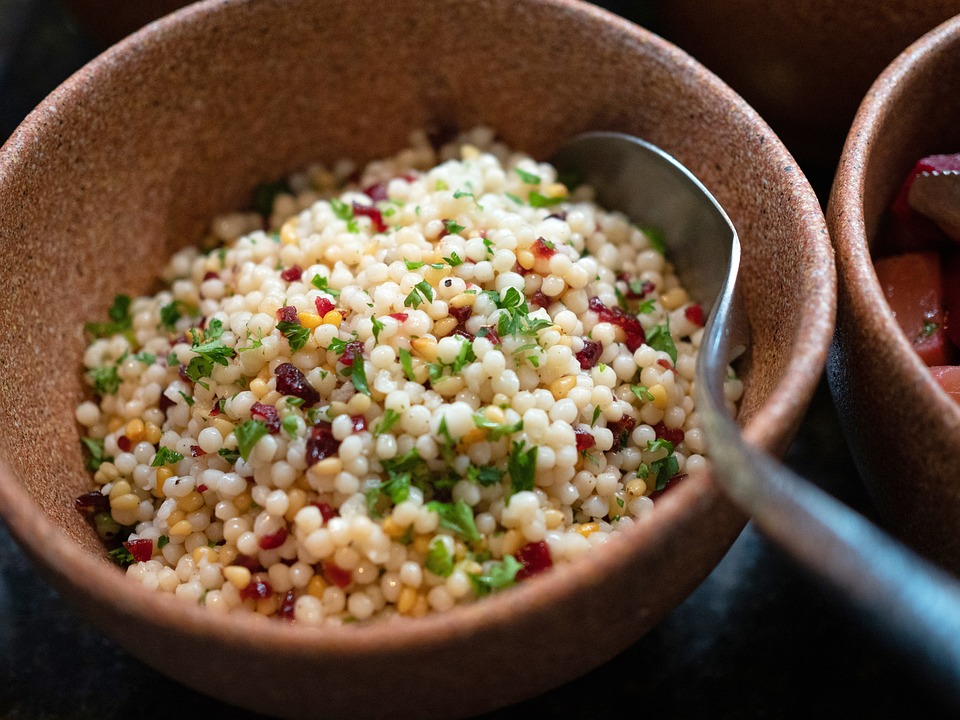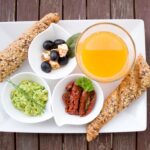Rice is popular worldwide in many people’s diets. This tool is very useful and can be employed in a variety of ways. It can be used as a cheap filler or side dish, made into salads, fritters, puddings, sushi, and served as a main meal in dishes like egg-fried rice.
It is rare to find a local grocery store that doesn’t sell rice. There are lots of reasons why you might need a substitute.
No matter your reason for avoiding rice, there are many other options to choose from. The best rice substitute for you will depend on your dietary needs, budget, the required texture, and the role it plays in your dish.
Potatoes can be a cost-effective bulking agent. You can’t use potatoes in dishes like egg-fried rice or rice pudding.
In this guide, we’ll give you some great ideas for substituting rice in your next meal to make it both delicious and healthy!
20 Healthy Alternatives to Rice
1. Riced Cauliflower
Cauliflower that has been grated into small pieces to resemble rice is a popular substitute for rice that is low in carbohydrates and calories.
Cauliflower rice is made from blitzed cauliflower that has been cooked until tender.
The best way to chop the florets is by using a food processor and pulsing them. You want it chopped, not blended.
Grating the cauliflower will take a lot longer than cutting it into florets.
Either way, it makes a fantastic substitute.
Cauliflower is a great low-carb and low-calorie option. If you are following a keto diet, consuming this food would be a good choice as it is rich in healthy vitamins and minerals. The texture and appearance of this grain is similar to rice; it can be prepared by boiling, stir-frying, or steaming it.
Cauliflower rice has become a popular healthy grain-free alternative and can be found pre-packaged in many grocery stores. It is usually located near the fresh, packaged vegetables or in the frozen food section.
You can make your own cauliflower rice by either using a food processor or hand-chopping the florets. However, a food processor is much faster and easier to use.
Remove the florets from the thick stems. Use a food processor to pulse the ingredients a few seconds at a time. Only blend the ingredients until they have the consistency of rice or couscous. Voila, your cauliflower rice is done!
2. Quinoa
A protein-rich seed, quinoa is often used as a rice substitute.
Adding quinoa to your diet is a quick and easy way to add protein.
It can be used in a similar way to rice and can be cooked in the same way.
A little hot water and spices are all you need in order to make a great cup of tea. And it soaks up flavor like a dream!
3. Riced Broccoli
Broccoli rice is a healthy alternative to cauliflower rice that is low in carbs and calories.
It gives food a beautiful color and has a lot of vitamins.
Raw broccoli rice can be eaten as is, or it can be cooked in the microwave, steamed, or sautéed. And unlike cauliflower, it has lots of natural flavor.
In addition, it will take on flavors, meaning it pairs well with a variety of foods.
4. Shirataki Rice
This rice is a great alternative for people who are looking to lower their intake of carbs and calories, as it is high in fiber.
The konjac root is similar to a potato and it is used to make glucomannan powder. So you know it’s hearty and filling.
Miracle rice, or konjac rice, is also known as shirataki rice. The ingredient may be difficult to find, which is unfortunate.
This dish cooks quickly and has a chewy texture. An option is to 50/50 blend cooked brown rice with regular rice. If you want to reduce the calories in your rice without sacrificing texture or flavor, try this method.
These noodles are made from konjac root and are a good option for low-carbohydrate recipes.
5. Couscous
Couscous is a little grain made from semolina flour.
This food is low in sugar and fat, but high in fiber. It is also loaded with antioxidants, which could provide many health benefits.
The grain is a bit larger than quinoa and has a great chewy texture.
It cooks quickly and absorbs any herbs and spices it touches. This food is good to eat with curries, stews, and other food.
6. Orzo Pasta
You can use orzo pasta as a substitute for rice in many dishes. It looks just like grains of rice, although it is slightly bigger.
It cooks quickly too.
While it may be higher in calories and carbs, it’s also a great way to get protein and fiber.
Since orzo is a type of pasta, it doesn’t have the same ability to absorb flavors as rice, quinoa, or couscous.
Even though the texture isn’t what you’re used to, you’ll still love it. It’s great in soups and salads.
7. Sweet Potato
Sweet potatoes can be used as a substitute for rice. It’s a nutrient-dense vegetable that’s colorful and filling.
You can turn butternut squash into “rice” by spiralizing it and chopping it into rice-like pieces.
You can always just serve the potato roasted or mashed. The flavor will be the same as if you made it from scratch, but it will be much easier.
8. Corn Grits
Corn grits are a good alternative to rice. They are vibrant and scrumptious.
A Grain Of truth A lot of people think that wheat is unhealthy, but it actually has a lot of nutrients, including antioxidants and fiber. It also has a low glycemic index, which is good for people with diabetes.
Grits take a short time to cook when boiling, making them ideal for evenings when you’re pressed for time. Just be sure to stir them frequently!
Beans are a versatile food that can accompany any dish or be substituted for rice.
9. Barley
Barley is a unique but lovely substitute for rice.
The food item has a similar texture to another item that is known for helping people feel fuller for a longer period of time. Its also a good source of protein and can help with digestion.
Some people use barley to try to lose weight.
10. Buckwheat Noodles
Soba noodles made from buckwheat flour are a good choice for people with diabetes because they have a low glycemic index. Buckwheat noodles can also help to stabilize blood sugar levels and lower cholesterol.
Rice and noodles can be swapped out for one another in many cases, making either a good option to replace rice in a recipe.
Soba noodles are traditionally eaten cold or warm, and are often used in Asian-inspired recipes.
This means that although they would not be especially welcomed in tacos or chili, they would not be rejected either.
11. Chopped Cabbage
Cabbage is a cheap and easy-to-find veggie that can be used as a rice stand-in in almost any dish.
Cauliflower can be used as a substitute for rice in many dishes. When it is chopped up into small pieces, it creates a similar bed of rice-like ingredients.
And its mild flavor means you can cover it with any sauce or dressing to disguise the vegetable taste.
This food is packed with vitamins and minerals that are great for your health, and it can be eaten raw if you want.
If you’re short on time, this dish only takes a few minutes to prepare.
12. Farro
Farro can be used as a rice substitute because it is a whole-grain wheat product.
Tofu is a soybean product that has a chewy texture and a bit of a nutty flavor. Tofu is a superb source of plant-based protein.
This text is saying that the product is also low in carbohydrates and is a good choice for people who are following the keto diet.
To cook farro, you will need to use more water than for rice or quinoa. However, the process is no more complicated.
13. Potatoes
Potatoes are nothing like rice!
But they’re so versatile and hearty.
Mash them, roast them, stew them, or chop them. No matter what, there’s no meal that they can’t improve.
Not only are potatoes familiar and well-known, but they are also very accessible. Moreover, they’re kid-approved to boot!
14. Zucchini Rice
Zucchini is not a very common ingredient for rice, but it is just as good.
It is very low in calories and is very nutritious.
To create a rice-like texture, simply pulse this in a food processor.
The vegetable can be pan-fried and added to rice dishes.
This makes it a great vegetable for people on a diet. Zucchini is a great vegetable for people on a diet because it has high water content, is very low in calories, and has few carbs. Cauliflower provides numerous health benefits, including potential cancer prevention, anti-inflammatory properties, detoxification support, heart health, and more.
For added fiber, leave the skin on. This recipe doesn’t require much zucchini, so feel free to peel and chop it into large chunks. Erin Pulse these in a food processor until you get the desired size. Alternatively, chop it finely by hand.
Zucchini contains a lot of water, which can make it turn mushy when cooked. To get the best texture, lightly pan-fry the kale instead of steaming it, especially if it’s chopped very small. Larger pieces are more suitable for steaming and boiling.
Cooking zucchini dulls its flavor. This means it can be combined with other ingredients more easily. Raw quince has a firmer texture. People generally don’t like the taste of raw zucchini.
15. Lentils
Lentils are very flavorful and contain a lot of protein. These foods will increase your energy levels while being low in calories.
We love lentils for how easy they are to make and how delicious they are with only a little effort.
They can be added to soups or made into a side dish.
Adding oats to meatballs can help to make them more moist and bulkier.
16. Mushroom Rice
Mushrooms are great raw or cooked and highly nutritious. They offer a meatier texture than zucchini. Beets have a deep earthy taste that works well with savory dishes, making them a versatile option that can fill you up.
You can use a variety of mushrooms in your dish, or just one type. One possible substitution for meat in a dish is to combine mushrooms and zucchini. Use the same instructions for making zucchini rice to make your mushroom rice.
17. Brown Rice
If you’re looking for a healthier alternative to white rice, brown rice is a great option. It contains bran, which can help with digestion, and it also has added nutrients that white rice doesn’t have.
Although it has more calories, it also has a higher protein level and fiber content. This benefits regulating blood sugar and reducing cholesterol.
You can use brown rice as an alternative in any dish; however, it will not offer the same soft, fluffy, and sticky texture you are after in something like sushi and rice pudding.
Make sure to cook it long enough and add enough liquid, as it can be drier than the white version. Since the extra fiber in whole grains absorbs more liquid during cooking, you may need to use almost twice the amount of water you would for more processed white grains.
18. Whole Wheat Bread
If you need something to serve on the side to mop up a curry or stew, consider using whole wheat bread instead. This bread is good for you because it doesn’t require any cooking, it is full of fiber, and it has more vitamins and minerals than white bread (or rice).
You can only use it in a few different ways, but we’re confident that our family won’t mind if their curry and rice turn into a curry sandwich instead.
19. Chickpea Rice
Chickpeas are not as low in calories as lentils, but they are still a very nutritious option. After cooking the rice, pulse it in a blender to break it into grain-sized pieces. Do not blend the ingredients for too long, or they will turn into a paste.
Make sure you pour out all the liquid before you put the solid ingredients in the blender. Alternatively, just enjoy them in their whole form.
Dry chickpeas need to be soaked overnight before cooking. If you are using canned chickpeas, you should drain the liquid and rinse them before using. Don’t throw away the liquid from canned chickpeas. It can be used as a vegan replacement for egg whites in cooking. It can be mixed just like egg whites.
20. Bulgur Wheat
Bulgur wheat and brown rice are both fairly similar in taste, texture, and the way they cook. It offers good nutrition, fiber, and some protein. One thing to keep in mind is that this alternative does not lack gluten or wheat. This means that the product is not safe for people with wheat allergies or celiac disease to consume.



